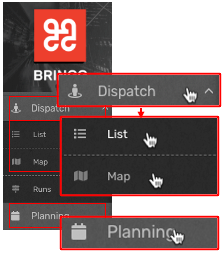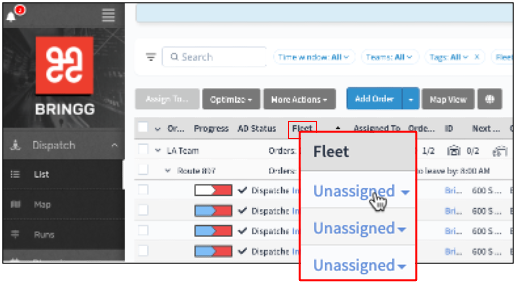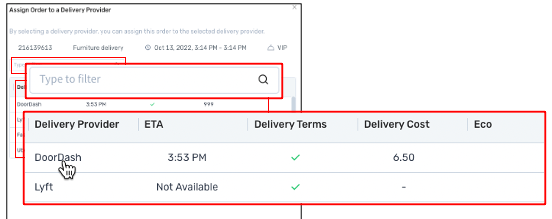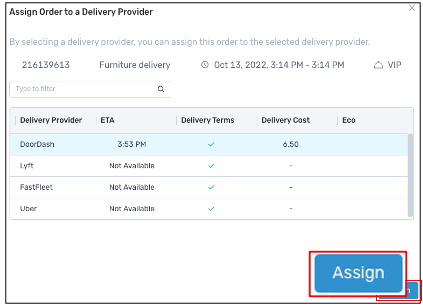You can assign orders to a carrier manually. For example, if Bringg is not able to find a carrier with the right skills.
Bringg can automatically assign orders to a Carrier using the carrier selector, ensuring every order is assigned in line with your business priorities and delivery strategy. Bringg can also assign an order to a different carrier if the first one can not deliver it. For example, if the carrier does not have a driver available to deliver within the order's time window. Learn more.
If you implemented a hybrid delivery network, you can also manually assign an order to your Own Fleet to have Bringg automatically choose a driver for an order.
Before You Begin
- Confirm you have a user of type dispatcher (or admin).
Tip
If you can't find a feature, ask your ops manager to add it or give you access by changing your permissions.
- Set up alerts for situations that may require manual assignment. For example, if an order must leave the fulfillment center soon to arrive on time but Bringg did not assign a carrier. Learn more.
Procedure
Step 1: Open Bringg and navigate to Planning, Dispatch > List, or Dispatch > Map.
 Access Planning or Dispatch
Access Planning or Dispatch
Step 2: Select the order's row in the Fleet column to open the list of available carriers.
 Open the list of available carriers
Open the list of available carriers
Step 3: Select a carrier that is available and qualified to fulfill this order. For example, select the cheapest fleet that can deliver the order on time.
Compare the order's details with the carrier's to guide your decision.
 Confirm the order's details
Confirm the order's details
Field | Description |
|---|
Order ID and order title | Use this information to confirm you selected the correct order. Order ID may include your ID or Bringg's ID. |
 | Choose a carrier with an ETA that falls within the order's time window to ensure the order is delivered on time. |
 | Choose a carrier that is qualified to deliver according to the details of the order's service plan. For example, only some carriers are certified for over the threshold deliveries. |
Total weight  | Choose a carrier with vehicles capable of delivering the order. For example, you may use a certain carrier with bikes to deliver light items and a different carrier t o deliverbig and bulky items with trucks. |
 Select a carrier
Select a carrier
Field | Description |
|---|
Delivery Provider | Find a carrier by its name. You can also search for carrier by entering its name in the search bar. |
ETA | The ETA indicates the time the carrier's driver can arrive at the first destination, for example to the fulfillment center to pickup the items to deliver. Choose the fastest carrier by selecting the carrier with the shortest ETA. Not Available indicates that either this carrier does not provide ETA information or could not due to a temporary issue. |
Delivery Terms | Select a carrier that is qualified to deliver the order. For example, select a carrier with trucks to deliver big and bulky orders. |
Delivery Cost | Save costs by selecting the carrier with the lowest cost. |
Eco | Select a carrier that can perform a green delivery. For example, a carrier that uses bicycles for short distance deliveries. |
Step 4: Select Assign to send the order to the carrier.
If you decide not to reassign the order, select Dismiss to keep the order with the current carrier.
 Assign the order to the carrier
Assign the order to the carrier
Bringg’s carrier selector automatically assign the best carrier for each order, in line with your business priorities and delivery strategy. For each order, Bringg checks the ETA or delivery price offered by each carrier. Bringg then automatically offers the order to each carrier, starting with the cheapest or fastest, until one accepts the order. Alternately, Bringg can offer order assignments to carriers according to a predefined sequence.
delivery strategy (delivery term)
A time window is the time range when you intend to fulfill an order. Therefore, an order is considered fulfilled on time if it arrives within the time window. The time window is set when you schedule an order in Bringg and is usually defined by the no_earlier_than and no_later_than fields. Narrower time windows are seen as better service, like 9 to 10 am, while longer windows are more typical of larger carriers.
You can share the time window with your consumers for an improved experience. For example, if a consumer places an order for the 8:00-12:00 the following day, in the morning notify them that you intend to arrive between 8:00-9:00.
If you allow consumers to select their preferred delivery slot, the time window is scheduled accordingly.
Your delivery network includes all the organizations that provide drivers and vehicles for your deliveries. This may include several third party carriers, external contractors or your Own Fleet. Allow Bringg to leverage your delivery network to extend your delivery coverage and minimize costs using the Delivery Hub.
A hybrid delivery network includes both your Own Fleet and third party carriers.
Admin is a type of user in Bringg who has the technical permission to access all functionality in the system. Usually this is the operations manager.
A fulfillment center is your home base and where you prepare orders for dispatch. It might be a store, warehouse, factory, garage, or restaurant.
You can configure Bringg to automatically perform actions when drivers approach your fulfillment center. For example, you can make a driver available for AutoDispatch, or take them on and off shift, without requiring them to manually check in. These actions are called home events.
Each team has at least one fulfillment center, and each fulfillment center can have one or more service areas.
The estimated time of arrival (ETA) is the time a driver is expected to arrive at a destination. Bringg's route optimization typically schedules an order's ETA to be within its time window.
A destination is the exact geolocated address associated with an order. The order may also have notes attached to help drivers access the correct destination. For example, arriving at an office complex, you need the building name, entrance number, access codes to enter, the floor number, room number, whether there are stairs or an elevator, the best place to park and so on. This information is often used to estimate the time on site.
A delivery strategy contains the terms you define per carrier that qualify them to fulfill a certain order. You may qualify a carrier by additional services they offer, types of vehicles they use, or their service area.
If you have agreements with multiple carriers, enter the terms of delivery for each provider. For example, you might want to use one carrier for fragile lightweight orders in the city center, while another might be best for all fragile orders in the northern suburbs.
For each carrier, you can create as many terms as you need, each describing a circumstance when you would use that provider. Each term can contain multiple conditions.
Then Bringg’s fleet router can assign each order to the preferred carriers according to your strategy.
Green delivery defines when an Own Fleet or carrier can fulfill orders using sustainable and eco-friendly means. This can be accomplished by using sustainable materials and eco-friendly vehicles (such as electric or hybrid vehicles, bicycles, or electric scooters) or committing to achieving carbon neutrality by investing in carbon offset projects (such as planting trees).
 Access Planning or Dispatch
Access Planning or Dispatch Open the list of available carriers
Open the list of available carriers Confirm the order's details
Confirm the order's details Select a carrier
Select a carrier Assign the order to the carrier
Assign the order to the carrier

